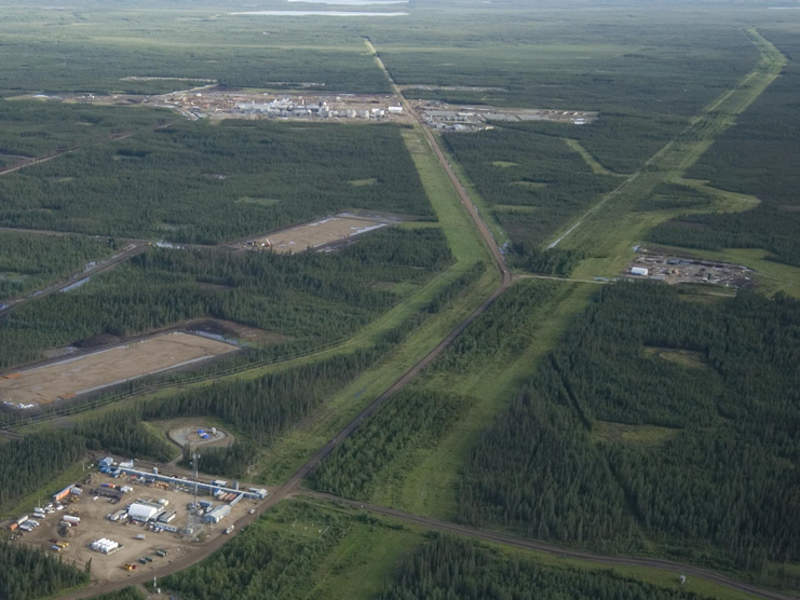

The Christina Lake project comprises approximately 200km² of oil sands leases in north-east Alberta, Canada. The area is part of the southern Athabasca oil sands region and is operated by MEG Energy Corporation.
The site currently produces at the rate of up to 82,000 barrels per day (bpd), and is being developed under a phase-structured schedule.
Phase three of the development received regulatory approval in 2012, and is expected to raise the rate of production to 210,000bpd. MEG is currently working towards increasing the processing rate from the existing phase 2B development.
The company announced a C$320m ($241.8m) investment in January 2017 to install enhanced Modified Steam and Gas Push (eMSAGP) technology for phase 2B, which is expected to increase production to 100,000bpd by 2019.
Timeline of the Christina Lake project
The first phase of the Christina Lake project featured a design capacity of 3,000bpd, and was originally approved in February 2005. Sustained production was established in March 2008 following the first successful extraction of oil.
MEG quickly ramped up the production rate to 22,000bpd at the onset of phase two, which was authorised in March 2007. Initial recovery for the second phase began in the third quarter of 2009 from well pads A, B, C, D, E, F and V.
Phase 2B followed in the third quarter of 2013, and further increased extraction to 60,000bpd. The production scale for this phase was expanded to a total of 12 well pads: M, N, J, K, G, H, T, U, AP, AF, AG and AN.
Oil is recovered using steam-assisted gravity drainage (SAGD) and eMSAGP technology.
SAGD and eMSAGP technology at Christina Lake
SAGD technology involves the use of pairs of stacked horizontal wells drilled to a depth of 400m into the reservoir. The top well injects steam into the reservoir, which heats the bitumen and separates it from the sand.
Bitumen and produced water are collected in the lower well 5m below, where it is then pumped onto the surface and the two substances are separated. Recovered water is recycled into the system, and accounts for more than 90% of water used.
The steam-oil ratio (SOR) indicates the efficiency of a SAGD operation, and an SOR of less than three is considered to be efficient, resulting in greater cost efficiency. The SOR of Christina Lake project is consistently rated at 2.5 or less.
MEG launched the use of eMSAGP technology at the Christina Lake site in order to improve the development’s SOR. The eMSAGP process involves injecting non-condensable gas and drilling infill wells inside the field in order to boost well pressure and improve overall oil recovery.
The procedure aids both the speed and efficiency of extraction, as well as maximising the amount of oil it is possible to recover from a given site.
eMSAGP technology was incorporated into the project as part of a pilot programme during phases one and two, and helped reduce the SOR from 2.5 to an average of around 1.3.
It has also assisted in lowering emissions and water usage, and the technology was implemented on a commercial scale at a number of the project’s other wells following the success of the pilot programme.
MEG plans to implement eMSAGP in phase 2B as part of its wider 2017 investment programme, which will see the drilling of infill wells and additional well pairs, as well as steam and minor debottlenecking procedures at the processing facility, all of which are to be completed by 2019.
It is estimated these operations will facilitate the increase of overall production in the area to highs of 100,000bpd.
Facilities at the Christina Lake site
The project site consists of a tank farm, oil processing facility, steam emulsion and natural gas lines, well pads, storm ponds and water recycling ponds.
The tank farm houses a number of tanks, which hold diluent for use in oil recovery and blended bitumen for shipment. The central oil processing facility is used to process the recovered oil, and separate both it and bitumen from the produced bitumen, gas and water.
Christina Lake project includes a network of steam emulsion and natural gas lines used to carry steam, gas and recovered oil to the central processing facility. The storm water ponds collect all runoff water, which is tested before being released back into the environment.
The site also contains a co-generation plant, which generates steam and water required for the operations. Excess electricity generated by the plant is fed into the Alberta power grid, helping reduce overall operating costs. Water-recycling ponds at the site store water recovered from the steam generation process, which is then recycled back into operation.
Oil recovered from the project is produced through well pads, which contain a minimum of six well pairs per pad. This helps reduce the carbon footprint of the well pads, and optimises net operational efficiency.



